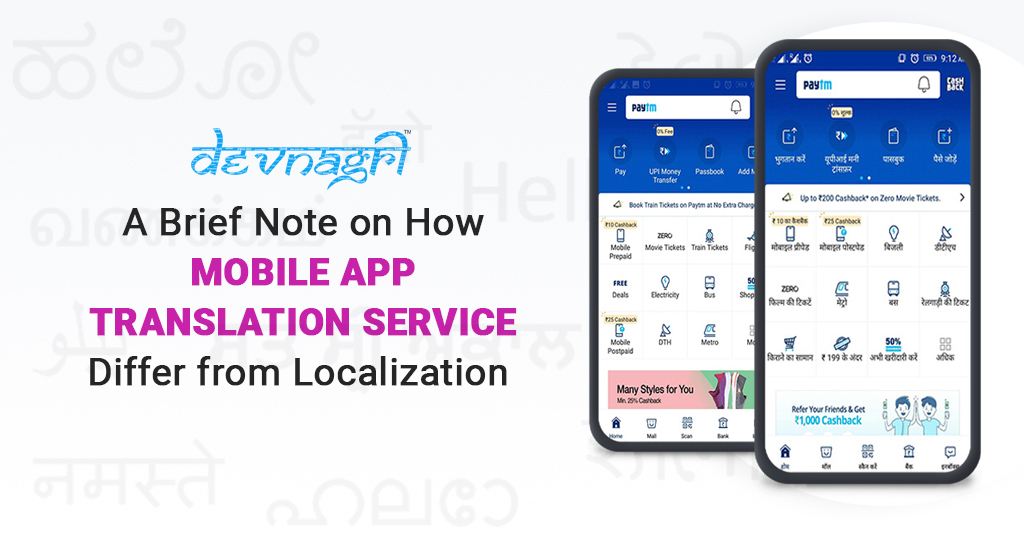
[:en]Two of the primary objectives to develop a mobile application is to increase your idea’s visibility and increase the exposure range. These are the core values that are going to help you get better Monthly Active Users (MAU). It eventually leads to generating higher returns and revenue! However, the works to be performed for attracting a wide range of audience is tricky and involves technical experience. For this expertise, people usually go with a reputed mobile app translation service provider to get their requirements done right.
Know that hiring a translation agency solely depends on the end purpose of your application. It means, to reach the target users, you may choose between app translation and app localization. Both sound similar, but there are a few pointers that distinguish each other in terms of the outcome.
The following information can be a useful resource to help you get a clear idea of whether your mobile application needs a translation or a localization service.
The Contrasting Features of App Localization and Translation
Let’s put it straight. The idea of translation is to change the language of a given document, media file, or book. It has to retain the meaning in the translated version. Here, we refer to the translated language as ‘target’ and the language that is given a translation as the ‘source’.
For better understanding, consider this example: By translating a movie from French to Korean, we mean that the source language is French and the target language is Korean.
Coming to the point of localization; this involves the change of language for a given context, but also by imbibing words and captions that are necessary for a given community to understand. The professional here will adhere to the cultural and aesthetic values of the country, people, and other target parameters.
Here is an example: By trying to make your German website reach the audience of Indians, then you will retain the layout and design elements of the site, but change the sentences, words, captions and other minute details, as per the Indian context.
By translating, you are making sure that the target audience understands what you are trying to convey. But with localization, you are directly interacting with the audience; hence, ensuring that every expression and ethnic factors of the context matches with the end-user.
Now, that we have defined what localization and translation means, you can decide whether to translate or localize your app. Do thorough market research and use analytics tools of your audience and then pick the ideal language service (s). And the best part is, you can invest in doing both app localization and app translation. So, for this particular condition, let’s see the characteristics that must be translated and localized in your app.
Localization Plus Translation: Elements You Need to Consider
When it comes to app translation, a majority of the international translation services work on changing the application’s words, sentences, phrases, and even sometimes captions present inside an image. But with app localization, the elements have to be translated and modified, based on the cultural background of the user. So, those aspects include:
- Current units (e.g. $, INR, Renminbi, etc.)
- Metric measurements (e.g. height, distance, weight, etc. )
- Format of the Date (ordering the date values)
- Idioms and expressions
- Visual graphics and animated pictures
- Spelling differences (e.g. color or colour)
- Comprehensible Words (e.g. cookies for biscuits)
An Additional Note on Both these Services
Whether it is app translation or localization, it is essential to keep in mind that the line spacing and page size are unchangeable. Of course, there are a few languages that are manageable in terms of length. For those cases, hiring an experienced mobile app translation service will be the only option.
Also, in the stance of providing culturally-acceptable and relevant elements, the app’s final product should respect the ethnicity of your target audience. So, attend to special situations where you are adding humour sense, relationship quotes, social values, religious notions, gender-oriented factors, and similar elements into your application.
Summarizing What We Learnt
- First, understand your target audience and then choose the language service appropriately. It can be app localization or app translation.
- App translation means you change the language of readable elements. App localization converts symbols, figures, pictures, etc. adapting to the culture of the end-user.
- App translation remains neutral to ethnic differences but app localization has specific racial requirements.
- It is advisable to hire experienced international translation services for furnishing the language requirements of your app with precision.
PRO TIP: In case, if you are hiring a mobile app translator, make sure that the concerned professional can show results that match your target audience and ethnic community. Because adapting to a specific locale is all about app translation and localization![:]




